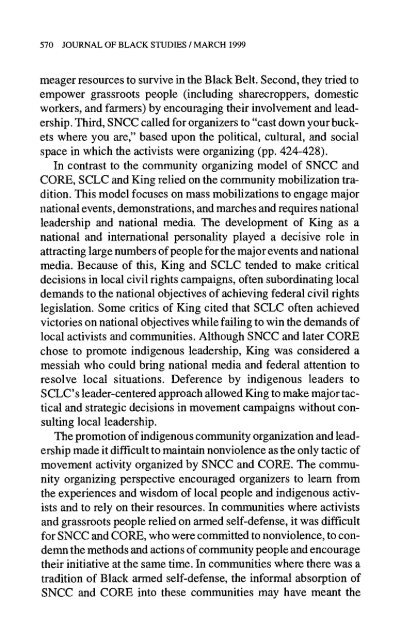MXGM Self-Defence Manual
MXGM Self-Defence Manual
MXGM Self-Defence Manual
Create successful ePaper yourself
Turn your PDF publications into a flip-book with our unique Google optimized e-Paper software.
570 JOURNAL OF BLACK STUDIES / MARCH 1999<br />
meager resources to survive in the Black Belt. Second, they tried to<br />
empower grassroots people (including sharecroppers, domestic<br />
workers, and farmers) by encouraging their involvement and leadership.<br />
Third, SNCC called for organizers to "cast down your buckets<br />
where you are," based upon the political, cultural, and social<br />
space in which the activists were organizing (pp. 424-428).<br />
In contrast to the community organizing model of SNCC and<br />
CORE, SCLC and King relied on the community mobilization tradition.<br />
This model focuses on mass mobilizations to engage major<br />
national events, demonstrations, and marches and requires national<br />
leadership and national media. The development of King as a<br />
national and international personality played a decisive role in<br />
attracting large numbers of people for the major events and national<br />
media. Because of this, King and SCLC tended to make critical<br />
decisions in local civil rights campaigns, often subordinating local<br />
demands to the national objectives of achieving federal civil rights<br />
legislation. Some critics of King cited that SCLC often achieved<br />
victories on national objectives while failing to win the demands of<br />
local activists and communities. Although SNCC and later CORE<br />
chose to promote indigenous leadership, King was considered a<br />
messiah who could bring national media and federal attention to<br />
resolve local situations. Deference by indigenous leaders to<br />
SCLC's leader-centered approach allowed King to make major tactical<br />
and strategic decisions in movement campaigns without consulting<br />
local leadership.<br />
The promotion of indigenous community organization and leadership<br />
made it difficult to maintain nonviolence as the only tactic of<br />
movement activity organized by SNCC and CORE. The community<br />
organizing perspective encouraged organizers to learn from<br />
the experiences and wisdom of local people and indigenous activists<br />
and to rely on their resources. In communities where activists<br />
and grassroots people relied on armed self-defense, it was difficult<br />
for SNCC and CORE, who were committed to nonviolence, to condemn<br />
the methods and actions of community people and encourage<br />
their initiative at the same time. In communities where there was a<br />
tradition of Black armed self-defense, the informal absorption of<br />
SNCC and CORE into these communities may have meant the


